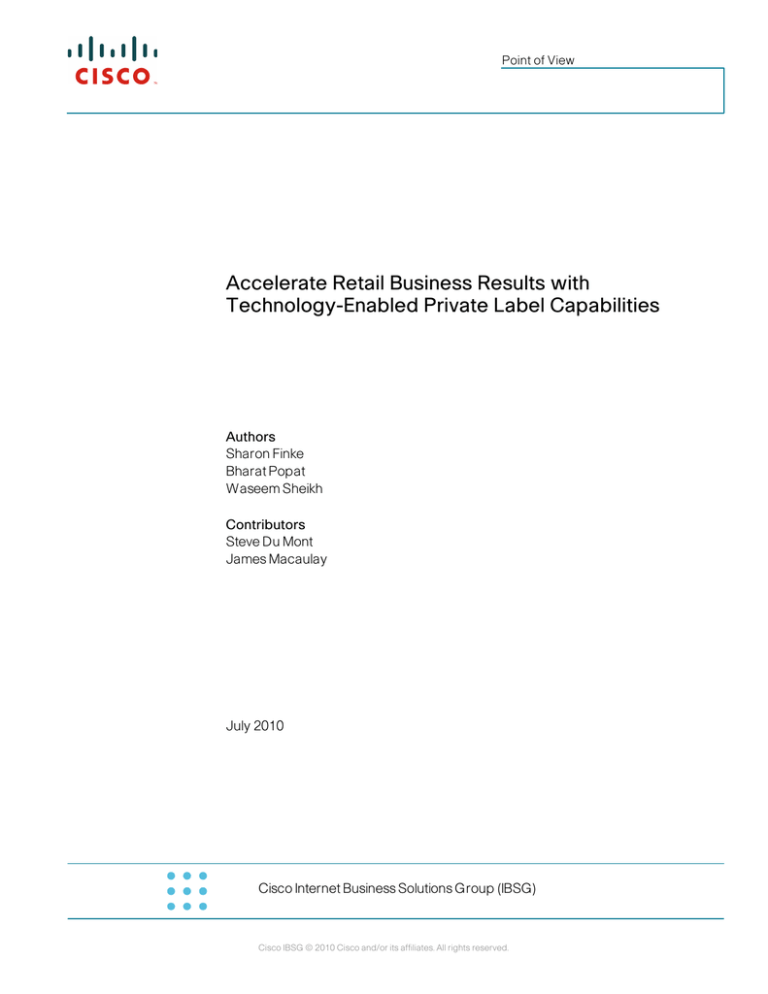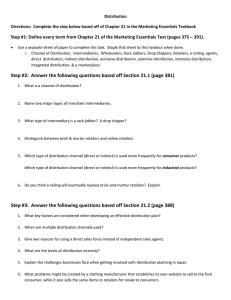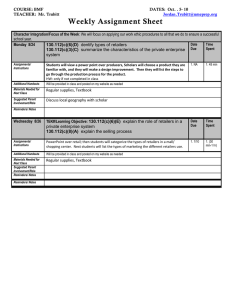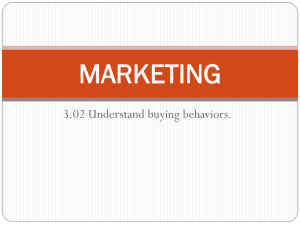
Point of View
Cisco Internet Business Solutions
Group (IBSG)
Cisco IBSG © 2010 Cisco and/or its affiliates. All
rights reserved.
Accelerate Retail Business Results with
Technology-Enabled Private Label Capabilities
Authors
Sharon Finke
Bharat Popat
Waseem Sheikh
Contributors
Steve Du Mont
James Macaulay
July 2010
Cisco Internet Business Solutions Group (IBSG)
Cisco IBSG © 2010 Cisco and/or its affiliates. All rights reserved.
Point of View
Accelerate Retail Business Results with Technology-Enabled
Private Label Capabilities
Overview
Under pressure to improve business results, retailers are accelerating their focus on
private label products to meet local tastes, deliver lifestyle choices, differentiate their brands,
and increase consumer loyalty. This is especially true in the United States, where private label
products typically account for just 15 percent to 20 percent of items on retailers’ shelves (by
comparison, private label products represent more than half of European retailers’ offerings).1
In the last six months of 2009, store-brand unit sales increased by 2.5 percent in the United
States, while national brands grew by only 0.4 percent.2 Private label now represents 19 percent
of U.S. retailers’ market value, up from 15 percent in 2003.3 This increase was accelerated by the
economic recession, which fundamentally shifted consumer buying behavior toward gaining
the most value for every dollar spent.
The rapid growth of store brands has resulted in private label capabilities that may lack the
approach, structure, and processes needed to achieve the healthy profit margins retailers
expect. Fortunately, new technologies are making it easier to gain consumer insights, develop
new products, and market to consumers. This is allowing retailers to mimic the capabilities of
consumer packaged goods (CPG) companies at lower cost, and with faster time to market.
To help retailers employ these technologies to improve their private label initiatives, the Cisco
Internet Business Solutions Group (IBSG) developed a two-phase maturity model that allows
retailers to assess their private label capabilities. With this information, they can develop plans for
progressing from today’s typical Private Label 1.0 level to the advanced and emerging
capabilities of Private Label 2.0. While retailers may take different approaches, it is possible to
achieve substantial improvements in shareholder value by embracing all of the technologyenabled capabilities described in this paper.
Key Trends Driving Growth of Private Label Products
Three trends are increasing the need for retailers to improve business results by developing,
placing, and marketing private label products:
1. Changing consumer behaviors due to the global economic crisis
2. Growing pressure to improve margins and combat increased competition
3. Shifting consumer attitudes toward private label products
Trend 1: Changing Consumer Behaviors Due to Global Economic Crisis
Due to the economic downturn, consumers redefined their spending patterns and changed the
way they shopped. Consumers are smarter: They are buying what they need, rather than what
they want, to extend their purchasing power. In fact, a recent Ogilvy survey indicated that 69
percent of consumers have rethought their buying perspective, and 79 percent have changed
Cisco IBSG © 2010 Cisco and/or its affiliates. All rights reserved.
Page 2
Point of View
their behavior for the better. People are paying more attention to product value and are being
more selective about where they spend their money.4
These newly adopted buying behaviors are expected to continue. A recent study of 800
households by GfK Custom Research for the Private Label Manufacturers Association (PLMA)
showed that as the economy recovers, the overwhelming majority—91 percent of U.S.
shoppers—will continue purchasing private label products.5
Trend 2: Growing Pressure To Improve Margins and Combat Increased Competition
Retailers are being “squeezed” between CPG companies passing on increased costs and
consumers wanting lower prices. Adding to this challenge is a perception that CPG companies
are quick to pass along rising commodity costs, but often are slow to reduce prices when costs
fall. Retailers, wanting to differentiate their offerings, also feel frustrated by the lack of control over
new product development and innovative offerings from their CPG partners.
These factors and the lure of greater margins have caused a steady rise in private label
products from retailers. More and more, retailers are “flexing their muscles” by replacing national
brands and using private label strategies as leverage in negotiations with CPG suppliers. As
examples, CVS recently replaced Energizer batteries with its own store brand, while Costco
temporarily removed Coca-Cola products from its stores.6 Because retailers currently have
greater control over product selection, tensions with their CPG partners are expected to
intensify.
Trend 3: Shifting Consumer Attitudes Toward Private Label Products
In addition to new attitudes about shopping due to the recession, consumers are gravitating
toward private label products for other reasons. According to Nielsen, 63 percent of U.S.
consumers consider private label brands to be of comparable quality to national brands, and 72
percent feel they are “good alternatives” to name brands (both increases are relative to prior
years).7
These findings are reinforced by recent analysis from KPMG, which states: “It used to be that
private labels served as low-cost and generally low-quality substitutes for national brands.
Today, nearly 75 percent of all U.S. consumers rate private label offerings as excellent in overall
quality. About 40 percent of consumers earning over $50,000 per year are in the ‘switch to
private label’ group. What was once the purview of discount shoppers is now attracting middle
and up-market buyers.”8
Private Label Development Is Flourishing
These trends are causing private label sales to flourish. In the United States, for example, private
label sales jumped 10 percent in 2008, to $83 billion.9 Additionally, a recent study by RSR
Research showed 70 percent of large retailers have increased their private label assortment in
the last two years.10
Even more important for retailers, gross margins from private label products are an average of
25 to 30 percent higher than from national brands. Some products, such as those in the beauty
category, can be store-branded at a 63 percent discount.11
Cisco IBSG © 2010 Cisco and/or its affiliates. All rights reserved.
Page 3
Point of View
Using Technology To Improve Private Label Business Results
Private label products give retailers a way to satisfy consumers’ needs, increase margins, and
differentiate themselves to increase loyalty and gain a competitive advantage. Today, many
retailers are developing a variety of innovative strategies that include co-branding, regional
customization, creative packaging, and new product innovations.
In pursuing these strategies, retailers have demonstrated varied levels of private label
capabilities that have directly impacted the results of their efforts. For example, a new entrant in
creative packaging generally is not as successful as an experienced retailer that has been
doing the same thing for several years.
To improve business results, Cisco IBSG developed a maturity model that allows retailers to
assess their private label capabilities (see Figure 1). The table also provides innovative ideas and
future capabilities to guide retailers as they progress from today’s Private Label 1.0 level to the
advanced and emerging capabilities of Private Label 2.0. By using this model, retailers can
develop roadmaps, experiment to gain experience, accelerate private label offerings, and
increase profit margins.
Figure 1.
The Maturity Model Allows Retailers to Assess and Enhance Their Private Label Capabilities
Source: Cisco IBSG, 2010
Cisco IBSG © 2010 Cisco and/or its affiliates. All rights reserved.
Page 4
Point of View
The maturity model is divided into five capabilities: 1) customer insights and brand strategy, 2)
product innovation, 3) concept development and testing, 4) value chain integration, and
5) marketing and promotions.
1. Customer Insights and Brand Strategy
Traditionally, retailers have analyzed point of sale (POS) and loyalty program information, as well
as market data from companies such as Nielsen, to understand what their customers are
buying. Many retailers also gain additional customer insights by collecting and analyzing
information from their websites.
Most recently, the growth of digital video, proliferation of smartphone applications, and rapid
growth of social networking and video platforms have created many rich, new repositories of
information. Retailers can now use data from these sources to “micro-segment” consumers
along various profiles, such as lifestyle preferences, to develop and target new brands. Linking
micro-segments to customers that frequent each store has also enabled retailers to localize
store-level assortments.
For example, Cabela’s is using in-store surveillance video to gather new information about
customers, such as ethnicity and gender, as well as behavioral data, including dwell times and
shopping patterns. This information helps the company segment its customers and understand
traffic patterns in stores. In addition, Hilton Hotels is using a conversation “listening” platform to
collect additional insights about its customers as they communicate openly on social networking
platforms such as Facebook and Twitter.
Although these emerging Private Label 2.0 opportunities increase the challenge of data
collection, integration, and analysis, retailers can tap the value of these new information sources
while reducing costs, lowering complexity, and mitigating risks. This can be done by creating a
customer insight platform using software as a service (SaaS) instead of buying and installing
software; by adopting cloud services for infrastructure; and by taking an open innovation
approach that provides an agile source of expertise beyond the four walls of an enterprise.
2. Product Innovation
Many of today’s Private Label 1.0 practices focus on sourcing “me-too” products from numerous
suppliers to increase margins and give consumers lower-priced alternatives to brand-name
products. To do this, retailers negotiate development of the same product with multiple suppliers
in an “arm’s-length” relationship. For retailers wanting to improve product innovation, Cisco IBSG
recommends creating a more collaborative, open-innovation environment by employing new
Private Label 2.0 capabilities that allow ideas to be suggested and built upon by communities of
employees, business partners, and customers.
Build fewer, more strategic partnerships for product development. Retailers can
accomplish this by pre-selecting strategic partners, entering into longer-term contracts, and
using collaboration technologies to create an open environment for idea sharing that produces
a continuous pipeline of new products. Open-innovation networks should include anchor
members (strategic suppliers), intermediaries, and relevant university resources.
This approach has several benefits. First, retailers save costs since they do not have to develop
the same internal R&D organizations that are currently burdening CPG companies. Second,
resources can be brought together as needed. This also reduces costs while adding a certain
level of business agility. Finally, retailers can gain a competitive advantage over CPG companies,
Cisco IBSG © 2010 Cisco and/or its affiliates. All rights reserved.
Page 5
Point of View
which have had difficulties establishing open-innovation networks due to entrenched business
cultures and large investments in their R&D organizations.
Solicit ideas directly from consumers and employees. For example, retailers can create
programs that encourage active participation through competitions and recognition. Cisco
recently created a contest called I-Prize that offered a $250,000 reward to the person who
came up with the best idea for the company’s next billion-dollar market opportunity. The
challenge resulted in approximately 2,000 new suggestions. The winning idea was for an
energy-management product that became a key component of Cisco’s smart grid solution.12
In addition to the significant prize offering, Cisco took a flexible approach to intellectual property
rights, which could either be shared or negotiated with the winner. This provided an extra
incentive for individuals to participate since they could benefit from the success of their idea in
the marketplace.
Outside of Cisco, a large manufacturer is deploying technology-enabled collaboration centers.
These centers allow dispersed teams to co-create and innovate in real time using virtual
whiteboards and Cisco® TelePresenceTM technology. These collaboration centers will allow the
company to find experts on-demand, bring them into virtual collaboration rooms to solve
problems, and develop new products faster and at lower costs.
Build an enabling-technology architecture. A technology architecture is required to support
the advanced and emerging capabilities described in the maturity model. This architecture
should include presence technology for intercompany collaboration and the ability to schedule
meetings on-demand; telepresence for rich video interactions; virtual whiteboarding to
brainstorm new ideas; shared spaces for staying organized; and community tools to provide
participants with relevant content.
3. Concept Development and Testing
Determining the design requirements for a successful product starts with a clear understanding
of consumer needs and wants. In most instances, observing how consumers use products
reveals more than evaluating data gleaned from surveys. This is because consumers’ actual
needs may be dramatically different from what they articulate. Unfortunately, the time and cost
of creating prototypes make testing products with consumers difficult.
Recently, however, advances in Internet technologies have created the ability to rapidly develop
and deliver virtual prototypes of physical products that can be used for testing with consumers.
These Private Label 2.0 virtual prototyping platforms allow retailers to reduce the time it takes to
test new concepts, improve results by involving more consumers in the testing process, and cut
the cost of product design.
Lego’s interactive community site (www.legoclick.com) is an example of this approach. The site
allows customers to build virtual prototypes and have their creations evaluated by the company.
This approach generates thousands of new product ideas each year and allows Lego to
evaluate new concepts easily and cost-effectively.
4. Value Chain Integration
Bringing new products to market requires five steps: 1) research and development,
2) design, 3) manufacturing, 4) delivery, and 5) support. Today’s Private Label 1.0 approach is to
have separate groups within a company manage these steps serially. In addition, outside entities
Cisco IBSG © 2010 Cisco and/or its affiliates. All rights reserved.
Page 6
Point of View
are not usually involved until late in the process. Bringing partners, suppliers, and other outside
parties into the product development process earlier can reduce total development costs by up
to 35 percent and speed time to market.13
As an example, a major beverage company involved in a product extension effort used Internetenabled technologies to “virtually co-locate” consumer research, design, manufacturing, sales,
marketing, and geographical teams. The company also implemented a rigorous program
management effort that incorporated input from suppliers and partners during the concept
stage, while maintaining and protecting every participant’s intellectual property. Due to this
approach, product formulations were reduced from 180 to just five, unit costs to develop an
initial product version dropped from $1.4 million to just $50,000, and design time was
compressed from seven man-years to less than one man-year.14
Across all retail industries, sources of innovation are multiplying while product and service
lifecycles are shrinking. These trends necessitate faster product development cycles.
Fast
Fashion, a Private Label 2.0 apparel manufacturing approach where product assortment is
frequently changed to meet rapidly shifting customer tastes, is at the leading edge of this
movement.
These trends are also being addressed by a move toward virtual integration. With this
approach, each participant focuses on core competencies (design, marketing, manufacturing,
sales, etc.). These competencies are then “virtually integrated” through the use of collaboration
technologies. The result is that retailers can achieve previously unattainable levels of business
performance.
5. Marketing and Promotions
The biggest difference between the cost of product delivery for retailers and that of CPG
companies is the amount of money spent on advertising: Retailers apply approximately
2 percent to 3 percent of revenues to promoting their products, while CPG companies spend 10
times that amount.15 This difference is the main reason retailers can maintain high margins on
private label products, even while selling them at lower prices.
In addition to the advantage of lower advertising costs, retailers control the space where
advertising is most effective—their stores. A recent study of six Western countries showed that
50 percent of consumers indicated in-store advertising was more effective at getting them to
purchase products, as compared to 36 percent who said television was the most effective.16
Post-recession consumer behavior is also causing consumers to spend more time in store aisles
looking for the best values. Because of these trends, CPG companies are paying a lot more
attention to what retailers are doing, and have allocated $542 billion to in-store advertising.17
Cisco IBSG believes that to maintain their competitive advantage, retailers should continue to
innovate with in-store advertising and employ the Private Label 2.0 advanced and emerging
capabilities recommended in the maturity model.
Another significant trend related to marketing and promotions is the increased usage of mobile
devices. In just two years, two-thirds of consumers will carry mobile devices, with nearly half of
these being smartphones. In addition, almost 70 percent of customers currently bring their
phones with them when they shop.18 Retailers can take advantage of these trends by using
context-aware mobile applications to increase sales and build customer loyalty.
Cisco IBSG © 2010 Cisco and/or its affiliates. All rights reserved.
Page 7
Point of View
Walmart, for example, has deployed an opt-in mobile application that sends SMS text alerts to
customers and provides links to the company’s mobile webpage. Ralph Lauren is using
2D barcodes in print ads to allow customers to take photos of the code and go to Ralph Lauren’s
mobile site to buy the product. This helps increase sales by making it more convenient to buy the
company’s products when the desire to purchase is strongest. These are just a couple of
examples from the thousands of applications being deployed for product promotion.
Today’s social media channels also offer a lower-cost, higher-return alternative to traditional
print and TV advertising. With Facebook now at 500 million users, and Twitter boasting more
than 120 million users, it is clear that consumers can be reached, engaged, and measured in
ways that weren’t possible just a couple of years ago.19
By taking advantage of social media, retailers can measure and optimize brand awareness,
perception, product affinity, and purchasing intent. They also have the ability to influence
consumer behavior to produce sales, co-create new business ideas, and generate leads.
For example, celebrities used a new voice-based social media service called “Bubbly” to create
demand for the hit film “Three Idiots” with nearly zero marketing dollars.20
Other examples include:
•
Dell—attributed $2 million in sales to promotions targeting the company’s more than
600,000 Twitter followers.
•
Charles Schwab—grew its Gen X customer base (consumers born approximately
between 1960 and 1979) 55 percent by tailoring targeted offerings via social media
sites.
•
Marriott—booked $5 million in revenue from customers clicking through to the
company’s reservations page from a Marriott Blog.
These are just a few of the fast-growing list of companies that have increased revenues through
use of social media. In the future, Private Label. 2.0 technologies such as interactive packaging
and electronic shelf labels will be available at price points that will allow retailers to develop new
ways to differentiate their brands and increase sales of their own private label products.
The Business Value of Private Label Innovation
By moving from today’s Private Label 1.0 environment to advanced and emerging Private Label
2.0 capabilities, retailers can improve business results in three ways (see Figure 2):
1) Greater Operational Efficiencies from Tighter Value Chain Integration
The integration of functions and partners—from design to delivery—is foundational, regardless
of a retailer’s private label strategy. Tighter integration is essential to deploy the advanced and
emerging capabilities that help bring retailers closer to faster and flawless execution. From these
efficiencies, the representative retailer in Figure 2, with annual revenues of $10 billion and gross
margins of 35 percent, can increase shareholder value by $1.4 billion, with an incremental gross
margin improvement of 1 percent.
2) Differentiation Through Increased Private Label Offerings Within Product Mix
Replacing national brands with private label equivalents to yield greater gross margins is a
logical place for most retailers to begin. By building a better product mix that more closely meets
customers’ diverse needs, retailers can drive greater wallet share and attract additional
Cisco IBSG © 2010 Cisco and/or its affiliates. All rights reserved.
Page 8
Point of View
customers. Assuming incremental revenues of $1 billion (10 percent of $10 billion in current
sales) and gross margin improvements of 36 percent to 50 percent, the representative retailer in
Figure 2 can increase shareholder value by $4 billion.
3) Increased New Business from Identifying and Satisfying Unique and Often
Undiscovered Customer Needs
Retailers can increase shareholder value from new business in two ways: 1) offering products—
and sometimes, related services—that are typically not offered at earlier stages of maturity, and
2) sensing and responding to opportunities before other retailers and
CPG companies.
Assuming incremental revenues of $1 billion at the higher gross margin of 50 percent (from
number 2 above), the representative retailer in Figure 2 can increase shareholder value by $6
billion.
(Note: This illustrative model is based on previous Cisco IBSG work with retailers and CPG
companies. Additional assumptions are listed in the “Endnotes” section.)22
Figure 2.
Based on a Representative U.S. Retailer, Shareholder Value Can Be Increased by 60 Percent
Source: Cisco IBSG, 2010
Next Steps
Multiple business drivers are causing retailers to aggressively pursue a higher percentage of
private label products. By moving to advanced and emerging private label 2.0 capabilities,
retailers can accelerate store brand offerings and improve shareholder value. To achieve these
goals, retailers should take three steps:
Step 1
Identify their current level of private label capabilities (today, advanced, emerging) from the
Maturity Model. Some retailers may be “advanced” in one capability and “emerging” in another
area. This is normal since retailers are at different stages of maturity depending on their
experience with—and commitment to—private label programs.
Cisco IBSG © 2010 Cisco and/or its affiliates. All rights reserved.
Page 9
Point of View
Step 2
Assess their private label programs and intent moving forward. Cisco IBSG believes private
label programs that employ more sophisticated strategies by using enabling technologies to
achieve “advanced” and “emerging” capabilities will increase efficiencies, product
differentiation, and new business opportunities.
Step 3
Form a team, establish executive sponsorship, and solicit ideas from other industries that
develop products targeted at consumers to assist with the development of a business
architecture, technology enablement, and business case to advance private label capabilities.
Endnotes
1.
Source: Cisco IBSG, 2010.
2.
Source: Nielsen, 2010.
3.
Source: just-food.com, July 15, 2009.
4.
Source: “How Consumers Rewrote the Old Recessionary Rules,” Fortune, May 4, 2010.
5.
Source: “Private Label Programs Take Off,” Brandweek, July 2009.
6.
Source: “From CVS to Costco, Retailers Put the Screws to Brands,” Advertising Age, July
14, 2010.
7.
Source: “Private Label Brands Gain Favor in the U.S.,” Nielsen Wire, November 17, 2008.
8.
Source: “Store Brands and the Recession,” Private Label Manufacturers Association, 2009.
9.
Source: “Private Label Brands Gain Favor in the U.S.,” Nielsen Wire, November 17, 2008.
10.
Source: “Designing and Delivering Merchandising that Sells,” RSR Research, April 2010.
11.
Source: “Designing and Delivering Merchandising that Sells,” RSR Research, April 2010.
12.
Source: Cisco, 2009.
13.
Source: Cisco IBSG, 2010.
14.
Source: Cisco IBSG, 2009.
15.
Source: Advertising Age, April 25, 2010.
16.
Source: Advertising Age, April 25, 2010.
17.
Source: Advertising Age, April 25, 2010.
18.
Sources: Cisco IBSG Economics and Research, 2009; Cisco IBSG Global Mobility Study,
2009; Cisco IBSG E-Commerce Survey, 2009; Gartner, 2009; Jupiter Research, 2009.
19.
Source: The Economist, July 24, 2010.
20.
Source: “Is Voice-Based Bubbly the New Twitter?,” Advertising Age, March 11, 2010.
21.
Source: Cisco IBSG, 2010.
Cisco IBSG © 2010 Cisco and/or its affiliates. All rights reserved.
Page 10
Point of View
22.
Calculations were based on a U.S. retailer with a starting shareholder value of $18.7 billion.
Key assumptions for the impact on shareholder value include:
●
Products: 118 in 30 categories. Of these, 50 products were selected as
representative
●
A weight was assigned to each product category based on a percentage of total
sales, category sales, and product margins.
●
Gross margin spread: 1 to 40 percent
●
Sales, general, and administration (SGA): 22 percent
●
Tax rate: 28 percent
●
New products have higher growth rates and deserve a higher price to earnings
multiple
Michael Adams of Cisco IBSG provided writing and editing assistance for this paper.
Cisco IBSG © 2010 Cisco and/or its affiliates. All rights reserved.
Page 11








